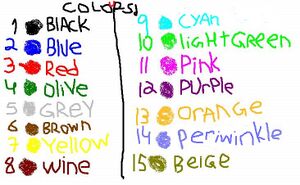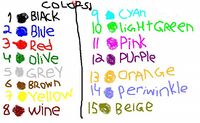Color regulations

Color regulations are the rules by which colors can look like. It was first organized by John F. Kennedy in 1959. After his assassination 4 years later, a new government agency was created. The most recent update was 4 years ago, when Green's color was changed from #008000 to #00ff00. It seems like they didn't like dark green being the color for all greens.
Regulations[edit | edit source]
Below is a list of all valid colors and their descriptions as of 2024.
| Sample | Name | Description |
|---|---|---|
| Purple | Because red and blue are primaries in both RYB and RGB, no matter what you're using, red and blue make purple. The sample provided is highly explosive upon contact with yellow, so we recommend not trying to make purple at home. | |
| Maroon | Everyone thought red was the first color...but everything changed when the maroon nation attacked...and then the purple nation. | |
| Red | One of the primary colors. If you don't know red, you are probably colorblind. | |
| Red Orange | Dude, we have good color names like crimson, but then we have just red-orange. Can we get any lazier? | |
| Orange | Created by mixing red and yellow. Make sure to dump as much yellow paint as you can for the most accurate result. | |
| Gold | Au... | |
| Yellow | One of the primary colors. Everybody associates yellow with positive emotions and sunshine, but we associate it with urine. | |
| Lime | It's the color of limes. How could you not know this already. | |
| Green | Created by mixing yellow and blue. However, in the world of RGB, it is a primary color. Hence, yellow and blue make gray. | |
| Turquoise | Mix green and aqua to make turquoise. They call this a gemstone, but it's just a rock. Don't believe the lies. | |
| Aqua | His ass is NOT a shade of blue. | |
| Blue | Just like red, it is a primary color in both RGB and RYB. Every 4-year-old boy likes it just because it's THE boy color. No other color is a boy color, not even aqua. | |
| Violet | It looks like you mix blue and red to make violet, but you actually mix blue and magenta. Don't believe the lies. | |
| Fuchsia | If you only take the hue of red and blue's mix in RGB, you actually get Fuchsia. Because of being calm to yellow compared to purple, but still looking like a purple color, Fuchsia is more highly used for colors of royalty. | |
| Magenta | In the CMYK color system, magenta exists. However, the more reliable source, Biv, Roy G[1], states that "magenta is all a hoax to get girls involved in the color scheme." | |
| Pink | The girliest color. If you claim to be a girl, but your favorite color is not pink, you're not a girl. | |
| Beige | People claim beige is a "neutral" color. In reality it looks so disguisting you could even put olive oil over it and it'd still look better. I love olive oil. | |
| Brown | Name anything brown. Poop, black people, steak...all of those are brown. Who wouldn't want to live in a world full of brown? | |
| Black | The void. Nothing more, nothing less. Anything people claim to be black is just a really dark gray. Don't believe the lies. | |
| Gray | Gray (or grey for the god-awful Europeans) is the true neutral color. Get out of the way, beige, the truest of neutral colors has come into town. | |
| Silver | Ag... | |
| White | No, please, not the white supremacists! I thought we were done with this already! |
Applications[edit | edit source]
There are many different applications for color regulations. Here are a few:
Marble races[edit | edit source]
Marble races and other things that fall under the "competition" umbrella need some way of distinction. Hence, color regulations give valid ways to do so.
General descriptions[edit | edit source]
If you need to give a general description for an object, like, say, paper, just pull out this list and say that you have some "ivory paper."
As you can see, there are many different ways to use color regulations. That's over one way! Can't you tell how much that is?
Footnotes[edit | edit source]
- ↑ This is not an actual person, we just made him up. Believe our lies please.
